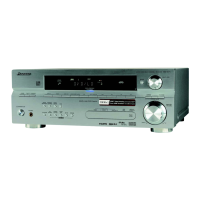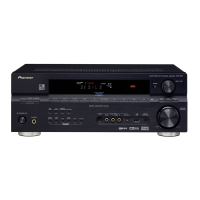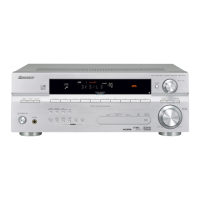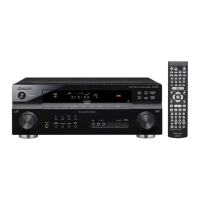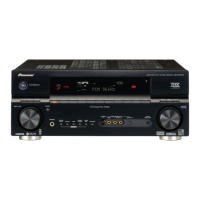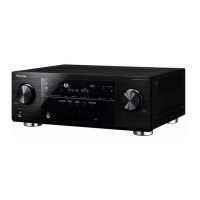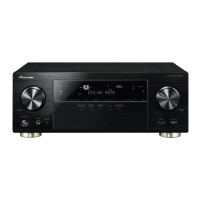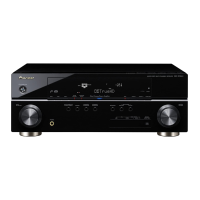
Do you have a question about the Pioneer VSX-919AH-S and is the answer not in the manual?
Provides guidance on operating the AV receiver.
Warnings about preventing electric shock and opening the unit.
Information on safety and replacement of the moulded mains plug.
Warnings about power supply voltage and operating environment.
Instructions for setting the voltage selector for different regions.
Cautions regarding proper ventilation to prevent overheating.
Guidelines for handling the power cord and standby switch.
Lists the accessories included in the receiver package.
Instructions for installing the receiver and loading batteries.
Description of buttons, dials, and indicators on the front panel.
Explanation of signal and program format indicators on the display.
Explanation of indicators for detected digital audio formats.
Buttons used to select input functions for components.
Buttons for controlling receiver and other connected components.
Overview of the input and output terminals on the rear panel.
Standard connection setup for 7.1 channel surround sound.
Setup for 5.1 channel surround with front bi-amping.
Setup for 5.1 channel surround with multi-zone audio.
Guidance on connecting fewer than 5.1 speakers and subwoofer.
Recommendations for optimal speaker placement and room acoustics.
Step-by-step instructions for connecting bare speaker wires.
Diagrams for connecting standard surround sound speaker systems.
Instructions for connecting speakers using bi-amping.
Instructions for connecting speakers using bi-wiring.
Configuration for audio playback in a second zone.
Configuration for using speaker system B.
Configuration for bi-amping front speakers.
Description of various audio input and output terminals and priority.
Explanation of the video converter and signal priority.
Instructions for connecting components using HDMI cables.
Instructions for connecting multi-channel analog audio outputs.
Details about the built-in Windows Media Audio 9 Professional decoder.
Instructions for improving FM and AM reception with external antennas.
Steps to establish connections for multi-zone audio.
Basic setup procedures for ZONE 2 audio output.
Using surround back speaker terminals for ZONE 2 setup.
Using the receiver's sensor to control other Pioneer components.
Instructions for connecting and controlling an iPod or iPhone.
Instructions for connecting and playing files from a USB device.
Guidelines for using AC power cords and plug converters.
Setting the speaker impedance (8Ω or 6Ω).
Adjusting the TV system setting for correct display.
Adjusting the tuning frequency step for station selection.
Setting the language for the Graphical User Interface screen.
Steps for automatically calibrating the audio system.
Important considerations before and during Auto MCACC setup.
Warning regarding the high volume of test tones used in Auto MCACC.
Detailed steps for completing the Auto MCACC calibration.
Guidance for resolving errors or issues during Auto MCACC setup.
Table showing default input terminal assignments and options.
Basic instructions for playing audio and video sources.
Selecting the desired input function for playback.
Navigating iPod music library by category.
Basic controls for playback, pause, skip, and repeat.
Detailed table of buttons for iPod playback.
Switching between receiver and iPod control of the device.
Troubleshooting and compatibility notes for USB devices.
Playing back audio files stored on a USB memory device.
Controls for playback, pause, skip, and repeat for USB devices.
Configuring settings for photo slideshows, including theme and BGM.
Controls for starting, pausing, and navigating slideshows.
Instructions for tuning into FM and AM radio broadcasts.
Tips for enhancing FM sound reception and quality.
Applying Neural THX technology for radio listening.
Directly entering a station's frequency using the remote control.
Steps for memorizing radio station frequencies.
Assigning custom names to saved radio station presets.
Recalling saved radio station presets.
Automatically selects surround or stereo playback based on source.
General guidance on listening to surround sound sources.
Basic surround sound modes for stereo and multichannel sources.
Steps for connecting KURO LINK compatible devices.
Crucial points to consider before using the KURO LINK function.
Important warnings and potential operational errors with KURO LINK.
Using KURO LINK with non-Pioneer TVs and players.
Adjusting various audio parameters like EQ, delay, and tone controls.
Converting video signals for output from MONITOR OUT jacks.
Specifying the output resolution for analog video signals.
Adjusting the aspect ratio for analog video signals at HDMI output.
Converting analog video signals to progressive signals.
Adjusting sub zone volume and selecting sources.
Table showing remote control functions for the MULTI-ZONE feature.
Table listing the default values for various system settings.
Using the remote to control up to three additional receivers.
Assigning remote control functions to other A/V components.
Entering 5-digit preset codes to control components directly.
Overview of accessing and navigating the Advanced MCACC menu.
Selecting calibration parameters for Auto MCACC (Expert).
Key considerations before and during Auto MCACC (Expert) setup.
Warning about high volume test tones during Auto MCACC (Expert).
Setting YES/NO for THX speakers.
Using multiple points for standing wave analysis.
Warning regarding high volume test tones during manual setup.
Key notes before performing manual MCACC adjustments.
Options for adjusting channel level, speaker distance, standing wave, and EQ.
Viewing calibrated settings for speaker setup, levels, and distances.
Viewing speaker size and number settings.
Viewing the output levels for each audio channel.
Assigning custom names to MCACC presets for easier identification.
Accessing and navigating the System Setup menu.
Making detailed manual adjustments to speaker settings.
Specifying connections for digital, HDMI, and component video inputs.
Accessing customized settings for receiver usage.
Configuring surround back speaker usage (Normal, B, Bi-Amp, ZONE 2).
Synchronizing receiver with KURO LINK components.
Configuring subwoofer gain and video input for multichannel sources.
Setting volume levels for MULTI-ZONE audio.
Setting the default volume level when the receiver powers on.
Limiting the maximum volume output level.
Resolving problems related to receiver power and operation.
Resolving issues where no image is displayed on the screen.
Troubleshooting video recording and signal quality problems.
Resolving issues with video signals from component terminals.
Resolving errors during Auto MCACC setup.
Correcting speaker size settings after auto calibration.
Troubleshooting problems adjusting speaker distance.
Resolving key lock activation and settings erasure problems.
Issues with EQ graph flatness and adjustment visibility.
Calibration appearance for SMALL speakers and low frequencies.
Troubleshooting display brightness and digital signal indicator problems.
Diagnosing and fixing issues where the remote is unresponsive.
Resolving remote control issues with other system components.
Resolving continuous blinking of the HDMI indicator.
Diagnosing and fixing HDMI connection issues for picture and sound.
Troubleshooting when HDMI picture or sound suddenly stops.
Addressing HDCP compatibility errors and messages.
Resolving issues with USB folders and files not appearing.
Troubleshooting when the USB memory device is not recognized.
Resolving problems playing audio files from a USB device.
Explanation of Dolby surround sound technologies.
Explanation of DTS surround sound technologies.
Description of the WMA9 Pro discrete surround format.
List of preset codes for controlling TV devices.
Preset codes for Plasma and LCD televisions.
Preset codes for CD players and Satellite/Cable Set Top Boxes.
Details on power output, distortion, and impedance.
Specifications for tuner frequency ranges and video signal levels.
Specifications for HDMI, USB, iPod, and control interfaces.
Power requirements, dimensions, weight, and furnished parts.
